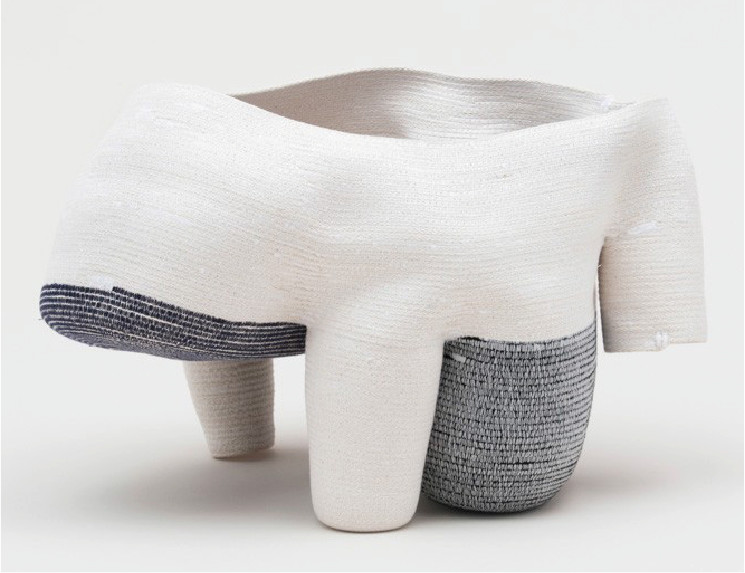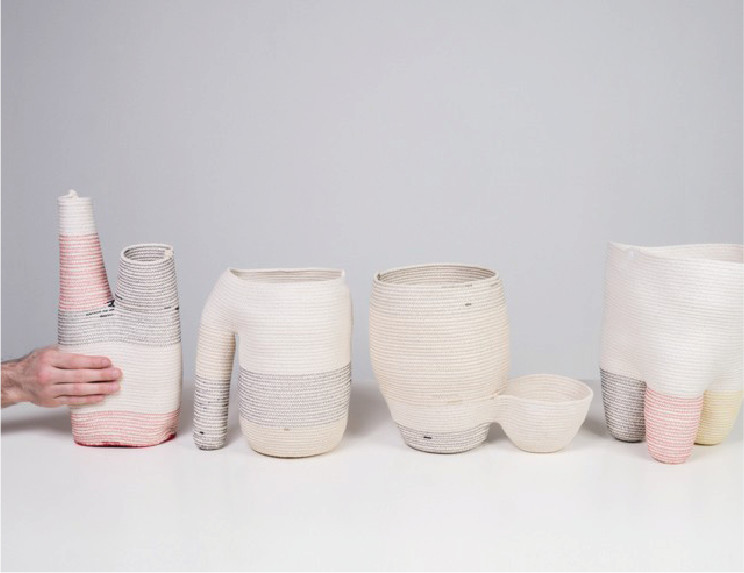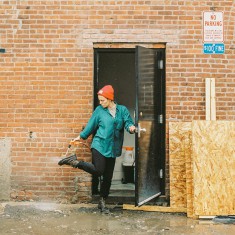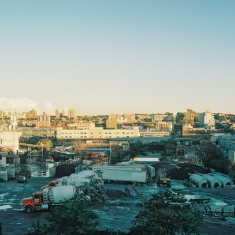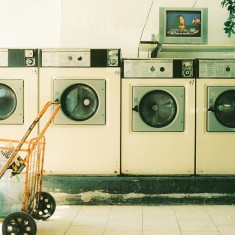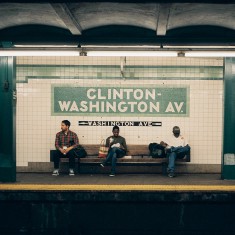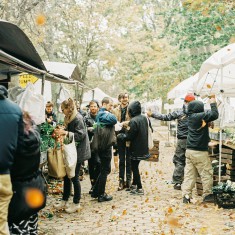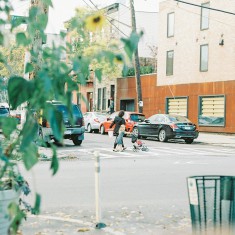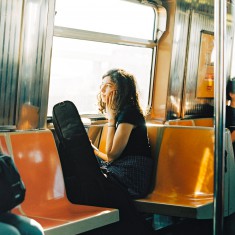DOUG JOHNSTON
コットンロープのアートピース/ダグ・ジョンストン
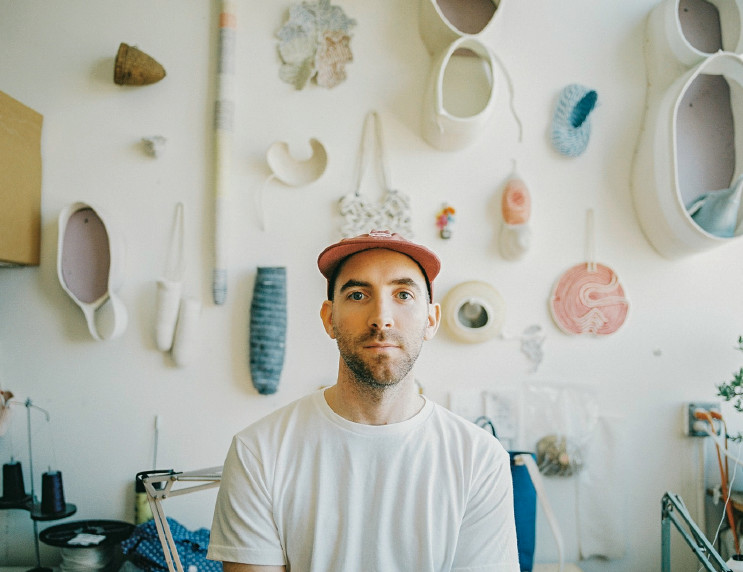
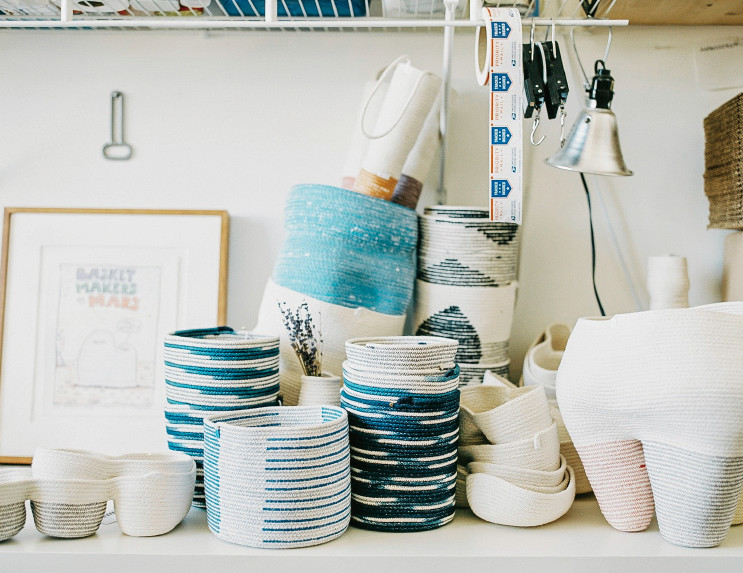
コットンロープの美しい可能性
ニューヨーク・ブルックリンのほぼ中央、プロスペクトパークサウスを拠点とするアートデュオ、ダグ・ジョンストンさんと松岡ともえさんは、暮らしの中にある身近な材料を使って、世界にひとつしかないアートピースを生み出している。ほっこりとした愛らしさと洗練された佇まいを備える彼らの作品は、手にしたひとの暮らしにすっと馴染み、日常に創造的な愉しみを添える。「手づくりの痕跡を隠すのではなく、デザインとして定着させているんです。マテリアルもプロセスも構造もオープンにして、作品を社会と共有していきたい」。そう語るのは世界屈指の建築/美術大学院クランブルック・アカデミー・オブ・アート在学中に出会ったという、アーティストのダグ・ジョンストンさんと松岡ともえさん。ふたりが作り出す独創的な作品の根底には、建築とアート、そしてソーシャルインタラクションに対する深い理解と敬意が息づいているという。彼らのものづくりの哲学に興味を抱いた私たちは、チャーチアヴェニュー駅付近にあるスタジオを目指した。
Brooklyn based art duo Doug Johnston and Tomoe Matsuoka use common household materials bought at a nearby store to create one-of-a-kind artwork. Their creations have a comforting loveliness while maintaining a masterfully crafted poise, fitting into an owner's life and supplementing their daily living space with a fun and creative twist. “We don't try to hide the hand-made look. It's an essential part of the design. We want to be open and honest with our materials, process, and structure in order to share our work fully with society,” says Doug Johnston and Tomoe Matsuoka. Doug and Tomoe met when they were students at renowned architecture, design and art school Cranbrook Academy of Art. Their work is rooted in architecture, art and a deep understanding of social interaction. Our curiosity peaked by their philosophy, we set out to visit the Doug Johnston studio near the Church Avenue subway station.
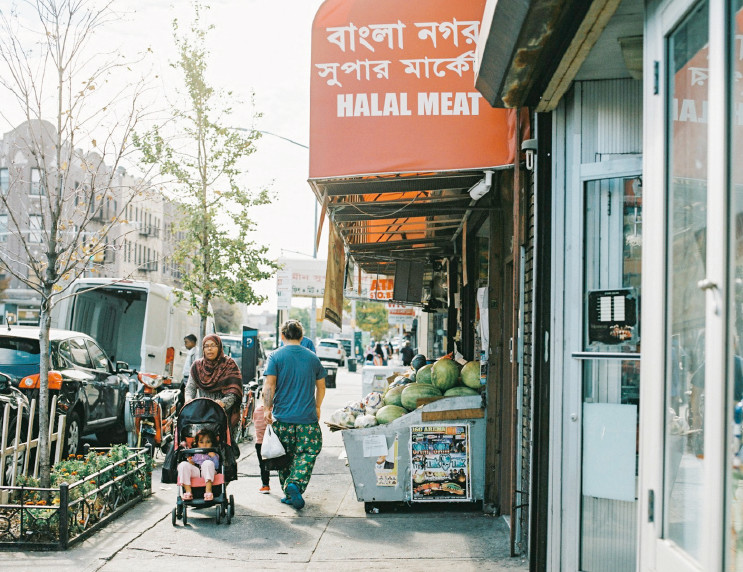
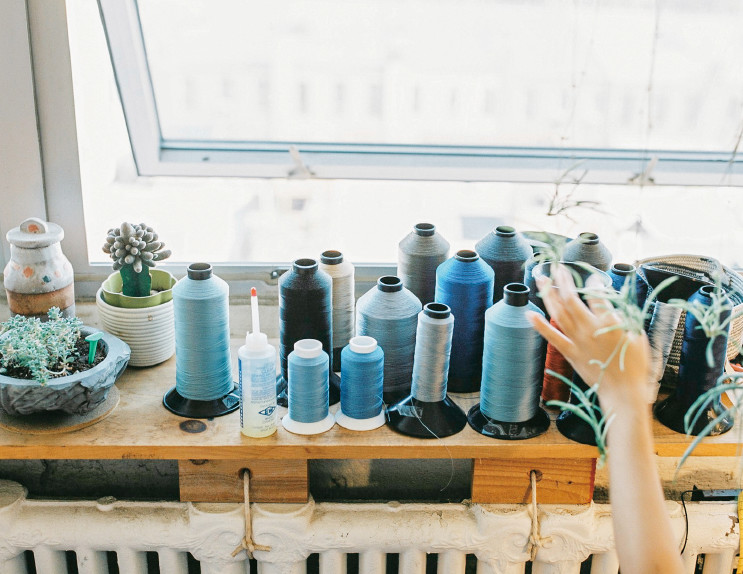


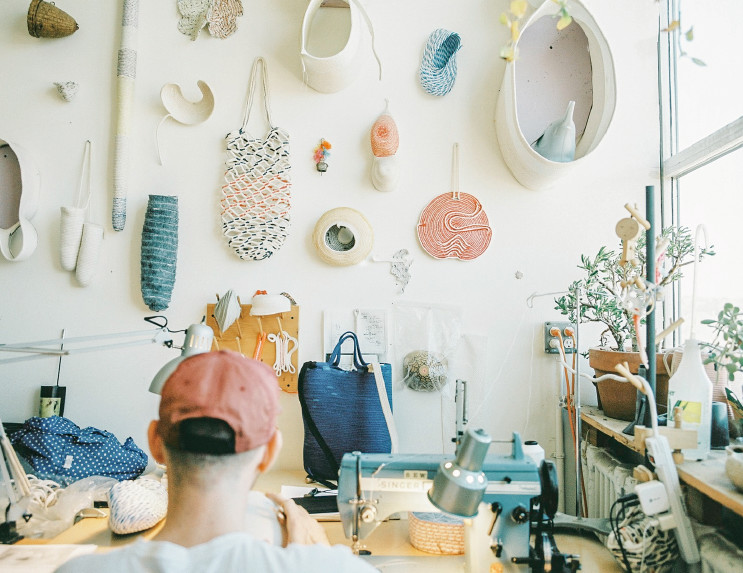
チャーチアヴェニュー駅から地上に上がると、ベンガル語やウルドゥー語のサインがまず視界に飛び込んできた。ストリートにはインド料理店やハラルを出すレストランが立ち並び、街ゆく人々の服装からも様々な宗教と人種が混在する多様なエリアだということが伺える。バングラディッシュやパキスタン系、そしてユダヤ系移民が多く暮らすという街は、典型的なブルックリンのイメージとは一見異なるようにも見えるけど、これも多様な文化を受け入れ変化を続ける巨大な都市が持つ性質の一面なのだろう。インダストリアルな雰囲気漂う無骨な建物の一角に、アート・デザインスタジオ〈Doug Johnston〉はあった。数名のクリエイターと共有する空間には、木を削る機械の音が響き、制作途中のペインティングが壁に重ねて立てかけられている。無造作に見える創造的な営みの痕跡は、ものづくりの現場特有の情熱的な息づかいを感じさせる。あたたかい笑顔で迎えてくれたダグ・ジョンストンさんと、パートナーの松岡ともえさんは私たちを自然光がたっぷりと差し込む作業スペースへと案内してくれた。
Stepping up onto ground level at Church Avenue in South Brooklyn we noticed signs in Bengali and Urdu. The streets were lined with Indian restaurants and halal meat markets. It was obvious the area was a cultural and religious melting pot. This city, where many Bangladeshi, Pakistani and Jewish immigrants have flocked, was somewhat different from what we expected – it must be yet another angle to this massive city that we were not aware of, one that accepts a diverse range of cultures and continues to change still. We found Doug Johnston Studio on the corner of an industrial looking building. The sound of a machine carving wood filled the space shared by a few artists, with half-finished paintings leaned against the walls. Art produced over the years have left their marks throughout the studio, evidence of a passion that is unique to artists working together in studios like these. Welcoming us with a warm smile, Doug Johnston and his other half Tomoe Matsuoka gave us a tour of the space pervaded by natural light.
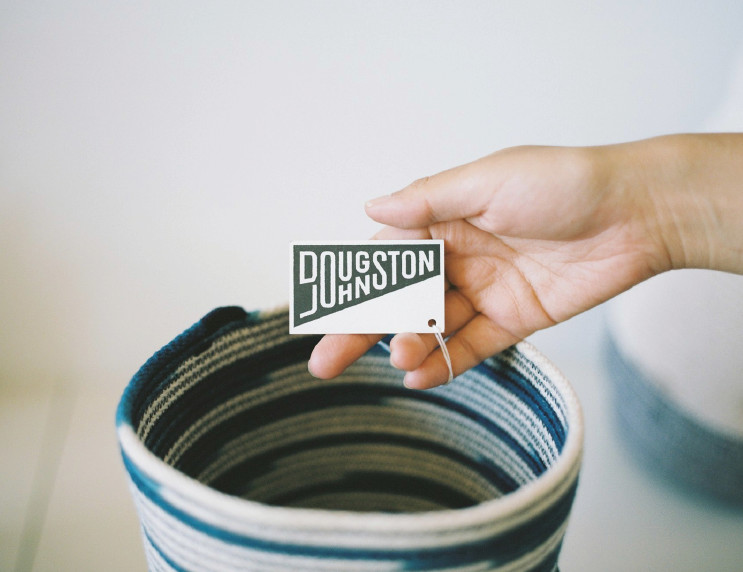
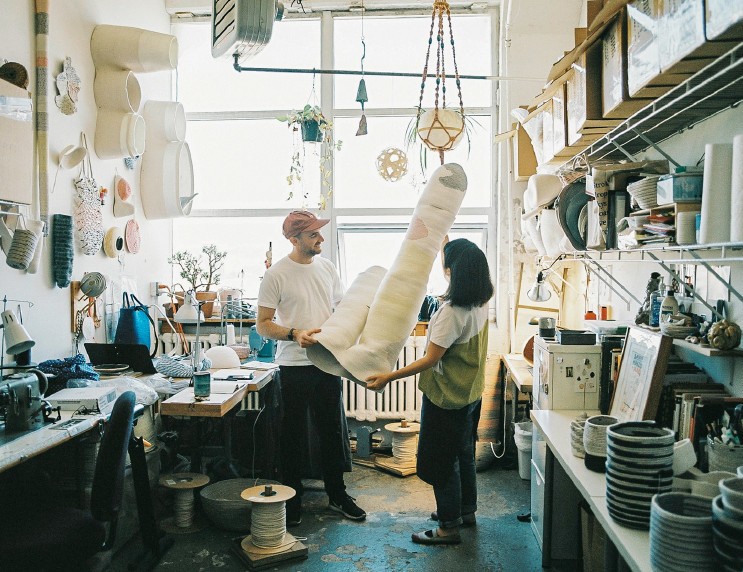
建築とアートの交わるところ
ふたりがコットンロープを素材にしたコイルバスケットの作品シリーズを発表し、大きな反響を得たことで活動を本格化させたのは2011年のこと。世界各地からオーダーが入るアートピースが生まれた背景には、ふたりの運命的な出会いと、ニューヨークに生活の拠点を移したことによる影響があった。
「もともとふたりとも大学では建築を専攻していて。だけど将来的には従来型の建築に完全に身を捧げるつもりはなく、かといってアートの世界に浸かるでもなく、その双方が交わる境界線上で仕事をしたいという思いがあったんです」。当時を振り返るともえさんにダグさんが続く。「お互いの興味がものすごく近かったことで、進学を選んだクランブルック・アカデミー・オブ・アートで僕らは出会った。その学校はちょっと変わった学校で、建築をはじめ、すべてのものづくりは、机上だけではなく、実際に素材とその組み立てのプロセスから生まれるものだということを学んだ」。世界中から集まってくる興味深いアーティストや建築家、そして現役アーティストの講師たちが揃うクランブルックでは、日常的に良質な議論が繰り広げられ、互いの創造性を研磨しあえる土壌がある。
「そのなかで私たちが特に情熱を持って取り組んだのがソーシャル・インタラクションという考え方でした。人と人との関係性を即し、出会いの場を作るようなインスタレーション、自分と他人の関わりを追求するような作品づくりに取り組んでいました」。
Doug Johnston received a great response to the release of their series featuring coiled baskets made of cotton rope and decided to step up production in 2011. The birth of these revolutionary pieces with international demand was due in part to the destined way the duo met and their relocation to New York.
“We both majored in architecture in college, but we never intended to devote our lives to that field in the conventional way. But we didn't find our selves deeply involved in the art scene either. We wanted to work somewhere in the intersection of those two fields,” says Tomoe. Looking back on their time in school, Doug continues, “We met after we both started at Cranbrook Academy of Art and quickly realized our interests were very similar. Cranbrook was a unique school where we worked as architects while also facing that work as artists. Artists and architects from all over the world came together and our teachers were all working artists. Discussions there were always heated and inspiring.”
“We found ourselves feeling especially passionate about the idea of social interaction. Not only did we want to encourage people to interact with one another through art, we wanted our art to be a point of interaction between ourselves and others.”

ニューヨークの新しい暮らしがもたらしたもの
卒業後、ふたりは大学院があるミシガンからNYへ生活拠点を移す。しかし2008年に勃発したリーマンショックの影響を受け、経済的にも精神的にも厳しい時期を過ごした。しかし、そんな環境の変化に呼応するように、ふたりの創作はゆるやかに変化を遂げることになる。
「ニューヨークに引っ越してからは、2年間くらいスタジオを持つことができませんでした。ご存知の通り、ここでは十分なスペースを確保するのはなかなか難しくて。そして、2008年にはリーマンショック。仕事も安定しなくなり次第に生活も厳しくなっていきましたね。正直、辛い時期ではあったけど、気づけば狭いアパートでも活動を続けられる小さな作品を作るようになっていって。その頃、私たちがやっていたことは、一本の紐を編むことでした。シンプルな動作を、何度も繰り返すことでできる今の作品の原型のような器状のものを作っていました。その作業はほとんど瞑想でしたね(笑)。その動作自体が精神をクリアにしてくるんです。その時の経済的な問題とか、仕事の心配、困難な状況からくる精神的なストレスを癒してくれるような。そうやって一本の紐の回転を繰り返しながら作った空間は、私たちにとって心地よいパーソナルな空間を表してるように思えました。たぶん当時、そんな安心できる空間を探し求めてたんだと思います」。
「その頃、ラインドローイングも好きで続けていたのを覚えてる。方眼紙に線をひたすら描き込んでいくんだ。ストレスの強い仕事をしてた時に通勤中電車のなかで描いていた。同じパターンを繰り返し繰り返し重ねていくようなドローイングだよ。ニッティングもそうだけど、同じ動作で繰り返し行う行為が好きなのかもしれない。また、ある意味、ニューヨークへ移ってきたことで身の回りの物事が一変したことに対する反応かもしれない。これまでこんなに狭く密集した大都市空間で生活したことはなかったからね。ひしめき合うビル群の形やなりたちも面白いし、そうした新たな要素に少なからず影響を受けたんだと思う」。
Upon graduating from Cranbrook in Michigan, Doug and Tomoe moved to New York. Following the financial crisis and economic depression of 2008, they went through an economically and mentally challenging time. Their creative process gradually evolved as they adapted to this changing economy.
“After we moved to New York, we couldn't afford to have a studio for about 2 years. As you know, it's difficult to acquire much space here. Then the financial crisis hit in 2008. Work became unstable and we began to struggle to make a living. It was a difficult time, but before we knew it we had come up with a process to make small pieces that could be produced in our little apartment. It involved coiling one piece of cord into various shapes. We made small bowl-shaped pieces that were made by a repetition of movements and it was those pieces that became the basis for what we create today. That work was practically meditation (laughing). The repetitive motions helped clear our minds and lessen mental stress that came with financial concerns and challenging times. All the pieces we created made our apartment personal and pleasant. I think we were seeking a comforting environment during that time.”
“I really like line drawing and I did a lot of that around then, too. I drew a lot on my way to work at a high-stress job. I'd often draw on the train. It's the kind of drawing where you keep repeating the same pattern over and over. Like knitting, I think I like repeating a motion to create the same shape many times. In some ways it might be a reaction to the complete change of environment I experienced when we moved to New York. I'd never lived in such a concentrated city environment before. The shapes and angles of buildings teeming in this limited space were very interesting and these new elements of the city affected my work in no small way.”
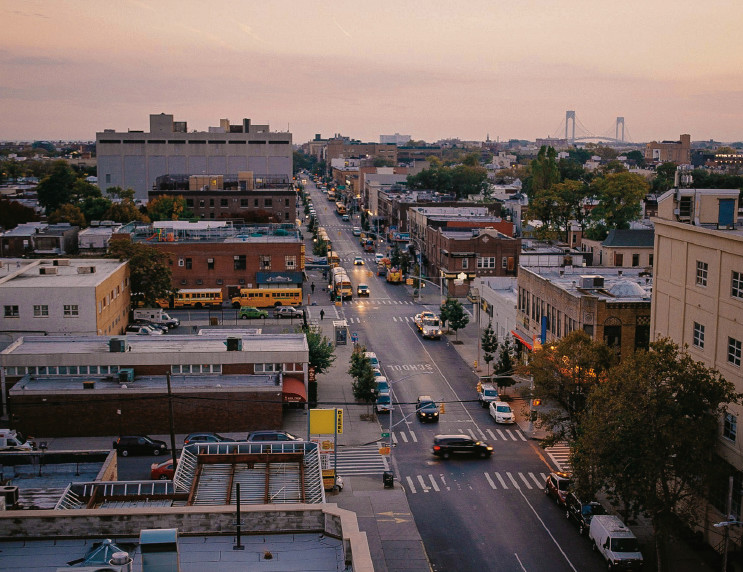
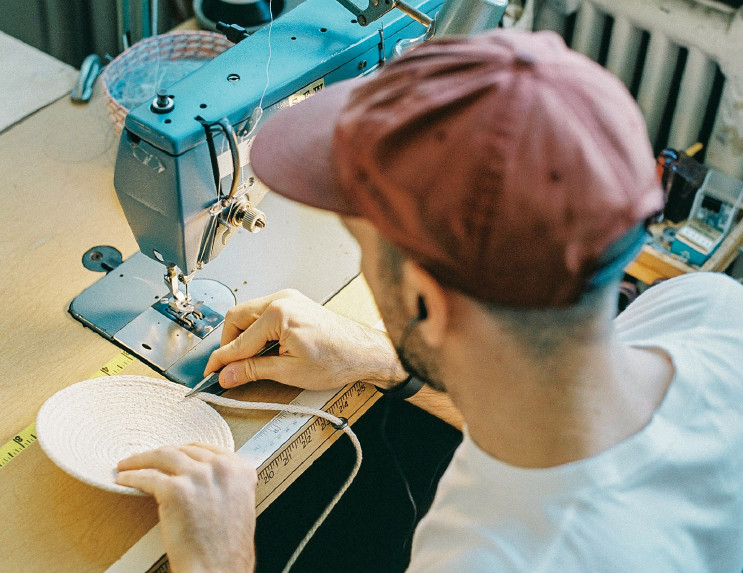
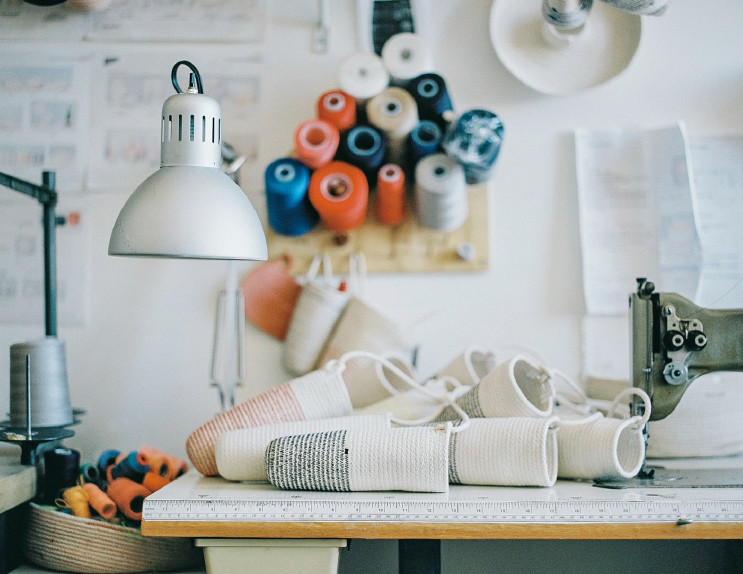
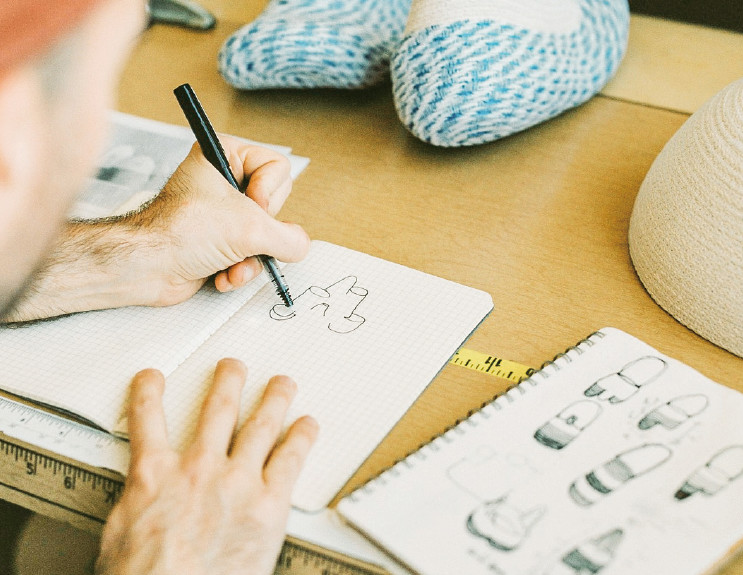
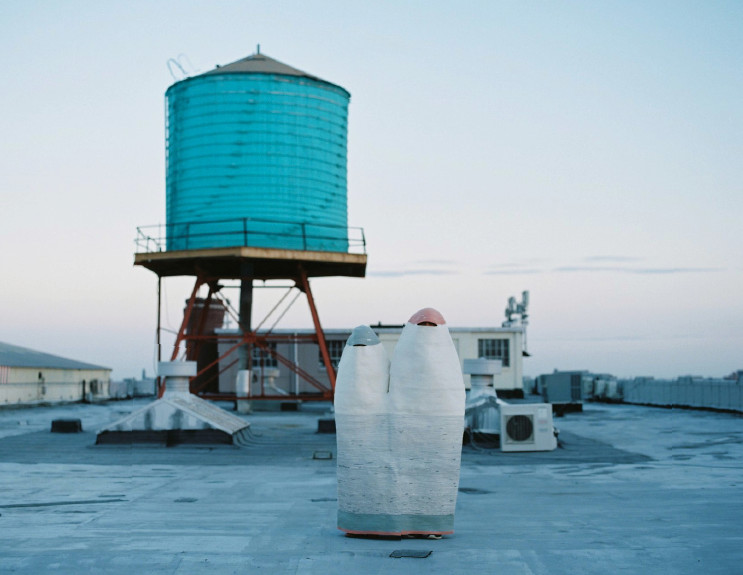
コットンロープとの出会いは近所の日用品店
高いビルが密集し、様々な人や文化がひしめくニューヨークの生活は、ふたりが取り組んできた空間づくりに対する価値観を発展させた。そしてものづくりにおける建築的アプローチを実現させたのは、近所の日用品店で偶然見つけたコットンロープの束だった。
「2010年1月、近所のダラーストア(安価な商品を揃える日用品店)でコットン製のロープの束が売っているのが目に入った。その手触りと質感に惹きつけられたんだ。これはバックパックを作るための素晴らしい素材になると思った」。日本で生まれ育ったともえさんが身につけていた縫製技術がそんなダグさんの創作意欲を支えた。シンプルで小さなバスケットづくりから始めたふたりだったが、そこには数え切れない試行錯誤の繰り返しがあった。しかし理想的なかたちを模索するなかで一縷のヒントになったのは、かつてアメリカの先住民が作ったコイル状の手編みのバスケットだったという。それはネイティブアメリカンの美術品に造詣が深い両親のコレクション。幼い頃に目にしたその美しいバスケットの佇まいが、進むべき方向を示すようだった。さらにコイル状の手編みバスケットについて深く調べていくうちに、ミシンを使った手法を紹介する映像にたどり着く。「その映像を見た時、すぐにたくさんの可能性が浮かんだんだ。これまで描き溜めていたドローイングが、ミシンを介して立体的に浮かび上がるようでワクワクしたよ。無限の可能性を感じたんだ。“あぁ、ぼくはこの作品を永遠に作り続けることができる!”ってね」。
Crammed with skyscrapers and people from diverse backgrounds, New York influenced the Doug and Tomoe's perspective on creating environments. Then, Doug discovered the material that solidified their architectural approach to making art.
“in January 2010 I saw a hank of cotton rope at the dollar store near our apartment. I was attracted to its texture and knew right away it would make a great material for a backpack.”
With that in mind, Tomoe shared some basket weaving techniques she had learned growing up in Japan, which helped Doug to begin making some simple, small baskets. However, it took a lot of trial and error and Doug continued searching for the right technique. Doug's parents in Oklahoma had a deep interest in Native American artwork and he remembered some of the coiled baskets they had collected since he was a child. After searching for videos on coiled basketry, Doug found videos on how to create coiled baskets using a sewing machine. “Immediately, so many possibilities came to mind. It was like all the line drawings I had been doing, but in drawn in three dimension with a sewing machine. It was a very exciting moment. I saw infinite potential, like ‘Wow! I could make these pieces forever!’


プロセスを創造の痕跡として表現に組み込むこと
「その映像に収められていた手法では、コイル状に巻いたロープをジグザグのスティッチで縫い合わせていた。モノフィラメントという透明の糸を使って縫い目を意図的に隠し、ロープ自体も布の端切で見えないように覆っていた。僕は、反対にこのコットンロープをそのまま使いたいと思った。せっかく良い手触りを持った素材なのに、それを隠してしまうのは惜しいと思ったから。それからジグザグスティッチも、ロープと糸がどのように接合しているのか一目でわかるように、色のついた糸を使うことに決めた。これは僕が、“ストラクチャー(構造)とコンストラクション(建造プロセス)のディテール、いわば設計者の意図と建造者の手仕事の痕跡そのものが装飾になる”という近代建築の考え方に共鳴しているから」。
「例えばこの初期のバスケット作品を見てください。ダラーストアで売られているコットンロープひと束の長さは100フィートなのですが、それを3束使って作ったことが分かるように、束のつなぎ目をあえて見せています。また、下糸を使いきり次のボビンに変更した経緯も、三重縫いのスティッチを目印として表現しています。作品を見てもらえば、私たちがどんな風に思考し、手を動かしたのか、制作プロセスすべてを伺い知ることができると思います」。
ふたりが思い描く社会に呼応するものづくりとは、自らの想像の痕跡を明らかにすることで、作品を介して次のものづくりを促すことにつながっていくことだ。そこには、インスピレーションを共有する美しい相互関係が存在している。
近所のダラーストアで手にしたコットンロープから生まれたバスケットは、世界各地のショップ、ギャラリー、エキシビションを通じて人々の暮らしに届けられるようになった。ダグさんとともえさんのスタジオでは、今日もミシンの音とともにひと編みひと編み世界とのつながりを生み出し続けている。
“In the videos of this technique they used clear thread called monofilament to hide the stitching. They also hid the cotton rope by wrapping in strips of cut fabric. I wanted to use this raw material because of its wonderful texture and thought it was a shame to hide it. Likewise, I thought using colored thread would be a way to show how the work is made. This appealed to me very much because of my interest in modern architecture, where there is a belief that structure and construction details can also act as decoration. In my mind the colored thread and its inherent inconsistencies are both the structure and the decoration that tells the story of the construction of the piece. Furthermore, this story of how the item is made connects back to our work in social interaction and relational aesthetics in a way. By seeing how a piece is made one can see the evidence of our work, our ideas, our hands. They could also even imagine themselves making such pieces, possibly encouraging them to employ their own creative skills for their own work. ”
“In every piece you can see how the rope is coiled and stitched together with colored thread. In the original pieces, the rope we used was purchased in 50 or 100-ft lengths, and one could see that a basket was made from one, two, or three separate lengths of rope. The details of the stitching would show where we changed thread to refill the bobbin. ”
Doug Johnston strives to create art that promotes social interaction by showing the pathway of their imagination and in turn encouraging further artistic creation. There is a beautiful aesthetic relationship in this shared inspiration.
Baskets born from the dollar store down the street are now delivered to people's lives through shops, galleries, and exhibitions around the world. Today in Doug and Tomoe's studio, the sounds of sewing machines echo out as each thread they weave tightens their connection with the world.

PROFILE
ダグ・ジョンストンの作品づくりのバックグラウンドは、アート、デザイン、建築、そして音楽など幅広い領域に及ぶ。これまでインスターレーションやファイバーアート、写真やパフォーマンスなど、さまざまな媒体・手法を行き来し、創造的な探索の中で創作を行ってきた。2010年からはロープをぐるぐる巻きつけながら縫いこんでいく、極めてシンプルなプロセスから生まれるCoiled Ropeシリーズの制作を開始する。以来アメリカ以来各地でエキシビションを開催し、数々のオンラインマガジンや雑誌で取り上げられ話題に。現在は世界各地のセレクトショップやギャラリーで取り扱いされている。
Doug Johnston's work has spanned art, design, architecture and music, utilizing and exploring a variety of mediums and methods such as installation, fiber art, sculpture, photography, and collaborative performance. Since 2010 he has focused on a process of coiling and stitching rope into a variety of functional and sculptural objects. His work has been presented in numerous exhibitions around the United States and in online and print journals; an ongoing line of coiled and stitched rope pieces is available in boutiques and galleries around the world.

